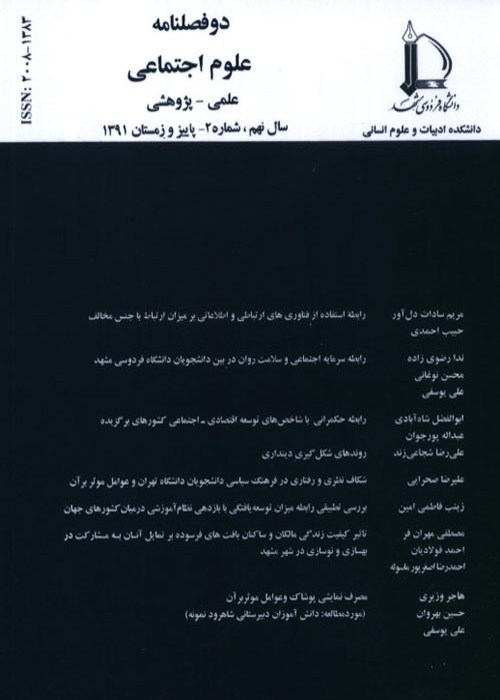Organizational Culture and its Impact on the Function of Social Institutions: Investigating the Attitudes of Employees of Library Organization, Museums and Documentation Centre of Astan Quds Razavi)
Author(s):
Abstract:
Introduction
Creating study centers and reading improvement are symbols of intellectual and cultural development in a society. In this regard, the library culture is one of the main factors. In fact, the dominant culture in a library has an inevitable role in meeting client's needs and also in death or life of the library as a social institution. Managing the organizational culture, in any countries, is one of the main responsibilities in an organization. It means the process that managers began to realize current and preferred culture, changes or optimizes the current culture toward preferred culture, evaluates change programs, and finally preserves or supports a culture (Kavoosi & Ghaumi, 2010). In some organizations, such as The Organization of Libraries, Museums and Documents Center of Astan Quds Razavi, manager's attention toward the quality of organizational culture is so important. It is because this organization, with following long-term goals, has many sections and clients. In fact, it is one of the most important treasures of written and unwritten culture in Iran and Islam world. Not only because of the library adjacency with holy shrine of Imam Reza but also for holy shrine authoritie's efforts in years, so there are unique treasures including numerous books, reports, magazines and newspapers, audio-visual educational matters, manuscripts and rare works of antiquity of Islamic history. In that regard, identifying current culture in a library, as Kaarst, Michelle, Nicholson, Von, Gisela and Stanton (2004) put it, helps managers to take advantage from strengths and overcome to weakness with more awareness. However, a main point is: usually organization members are unaware of their organizational culture and this unawareness would be persisting as long as nobody could not identify or challenge the current culture (Cameron & Quinn, 2011). Regarding the importance of organizational culture in libraries, so the purpose of this research is to examine managers and employees attitudes toward current and preferred culture in The Organization of Libraries, Museums and Documents Center of Astan Quds Razavi.Theoretical Framework: Schein (2010) defines the culture as: A pattern of shared basic assumptions that the group learned as it solved its problems of external adaptation and internal integration that has worked well enough to be considered valid and, therefore, to be taught to new members as the correct way to perceive, think, and feel in relation to those problems. There are different theories of organizational culture. Cameron and Quinn (2011) proposed one of the most popular and comprehensive theories of organizational culture which is used in this research as a theoretical framework. They believe that there are four dominant culture types including: hierarchy, market, clan and adhocracy. The "hierarchy culture" is a highly structured organizational environment that is characterized by governing formal rules on member's activities. Maintain a smooth running organization is important and the long-term concerns of the organization managers are stability and predictability. The "market culture" is oriented toward the external environment and its customers instead of internal affairs. It is focused on productions, potential customers, making money, finding effective commercial environment and creating competitive market, so the major focus of the culture is to conduct transactions (exchanges, sales, contracts) with other constituencies to create competitive advantage. In the "clan culture", interactions between members seemed more like extended families. Instead of the rules and procedures of hierarchies or the competitive profit centers of markets, typical characteristics of clan type firms were teamwork, employee involvement programs, and corporate commitment to employees. The major task of management is to empower employees and facilitate their participation, commitment and loyalty. In "adhocracy culture", innovative and pioneering initiatives are what lead to success. The major task of management is to foster entrepreneurship, creativity and activity on the cutting edge. So, employees were encouraged to formulate innovative solutions to problems and to generate new ways of providing services to clients (Cameron & Quinn, 2011).
Methodology
This study was carried out via descriptive method, the population consisted of all 385 employees in The Organization of Libraries, Museums and Documents Center of Astan Quds Razavi. Due to small population size and extremely low access to them, participants were 175 employees of the Organization of Libraries that they were selected based on convenient sampling. Cameron and Quinn questionnaire was used. This questionnaire was standardized by Abbassi in 2008 with a high reasonable degree of reliability (0.91). The hypotheses are the following: 1. There is a significant difference between managers and employees attitudes in The Organization of Libraries toward current culture.2. There is a significant difference between managers and employees attitudes in The Organization of Libraries toward preferred culture.
Results
Hypothesis testing indicated that there was no significant difference between managers and employees attitudes toward current culture. In another word, the two groups were similar in defining the current organizational culture as a hierarchical culture. Also, there was no significant difference between managers and employees attitudes toward preferred culture. All participants were believed that the clan culture would be the best model for effective performance in the Organization of Libraries.Conclusion
In sum, result shows that hierarchical culture is dominated in the organization and it is not a suitable one; instead, both managers and employees have positive attitude toward creating a clan culture. Managers attitudes, beliefs, values and behaviors are important factors in creating such an appropriate culture. A manager is a culture creator that he can affect his employees behaviors by his way of doing things as a role model. So, for establishing a suitable culture and preventing managers resistance, first of all, it is important to justify them. So, managers awareness toward desired consequences of clan and adhocracy culture for achieving organizational goals have been increased.Regarding the role of organizational culture in accelerating organization development and also the time-consuming process of changing organizational culture, it is better to recognize strengths and weakness of current hierarchical culture and gradually move toward clan and adhocracy cultures.
Keywords:
Language:
Persian
Published:
Journal of Social Sciences, Volume:13 Issue: 2, 2017
Pages:
213 to 236
magiran.com/p1683931
دانلود و مطالعه متن این مقاله با یکی از روشهای زیر امکان پذیر است:
اشتراک شخصی
با عضویت و پرداخت آنلاین حق اشتراک یکساله به مبلغ 1,390,000ريال میتوانید 70 عنوان مطلب دانلود کنید!
اشتراک سازمانی
به کتابخانه دانشگاه یا محل کار خود پیشنهاد کنید تا اشتراک سازمانی این پایگاه را برای دسترسی نامحدود همه کاربران به متن مطالب تهیه نمایند!
توجه!
- حق عضویت دریافتی صرف حمایت از نشریات عضو و نگهداری، تکمیل و توسعه مگیران میشود.
- پرداخت حق اشتراک و دانلود مقالات اجازه بازنشر آن در سایر رسانههای چاپی و دیجیتال را به کاربر نمیدهد.
In order to view content subscription is required
Personal subscription
Subscribe magiran.com for 70 € euros via PayPal and download 70 articles during a year.
Organization subscription
Please contact us to subscribe your university or library for unlimited access!



